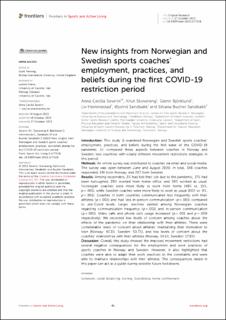| dc.contributor.author | Severin, Anna Cecilia | |
| dc.contributor.author | Skovereng, Knut | |
| dc.contributor.author | Björklund, Glenn | |
| dc.contributor.author | Hemmestad, Liv B | |
| dc.contributor.author | Sandbakk, Øyvind Bucher | |
| dc.contributor.author | Sandbakk, Silvana Bucher | |
| dc.date.accessioned | 2024-01-19T12:53:39Z | |
| dc.date.available | 2024-01-19T12:53:39Z | |
| dc.date.created | 2023-12-05T07:38:11Z | |
| dc.date.issued | 2023 | |
| dc.identifier.citation | Front. Sports Act. Living, 27 October 2023 Sec. Sports Coaching: Performance and Development Volume 5 - 2023 | en_US |
| dc.identifier.issn | 2624-9367 | |
| dc.identifier.uri | https://hdl.handle.net/11250/3112835 | |
| dc.description.abstract | Introduction: This study (i) examined Norwegian and Swedish sports coaches’ employment, practices, and beliefs during the first wave of the COVID-19 pandemic, (ii) compared these aspects between coaches in Norway and Sweden, two countries with clearly different movement restrictions strategies in this period.
Methods: An online survey was distributed to coaches via email and social media. The survey was open between June and August 2020. In total, 348 coaches responded, 141 from Norway, and 207 from Sweden.
Results: Among responders, 2% had lost their job due to the pandemic, 17% had been furloughed, 28% worked from home office, and 39% worked as usual. Norwegian coaches were more likely to work from home (48% vs. 15%, p < .001), while Swedish coaches were more likely to work as usual (60% vs. 9%, p < .001). Coaches in both countries communicated less frequently with their athletes (p < .001) and had less in-person communication (p < .001) compared to pre-Covid levels. Larger declines existed among Norwegian coaches regarding communication frequency (p < .001) and in-person communication (p < .001). Video calls and phone calls usage increased (p < .001 and p = .009 respectively). We recorded low levels of concern among coaches about the effects of the pandemic on their relationship with their athletes. There were considerable levels of concern about athletes’ maintaining their motivation to train (Norway: 43.3%, Sweden: 50.7%), and low levels of concern about the coaches’ relationships with their athletes (Norway: 14.1%, Sweden: 17.8%).
Discussion: Overall, this study showed the imposed movement restrictions had several negative consequences for the employment and work practices of sports coaches in Norway and Sweden. However, it also highlighted that coaches were able to adapt their work practices to the constraints and were able to maintain relationships with their athletes. The consequences raised in this paper can act as a guide during possible future lockdowns. | en_US |
| dc.language.iso | eng | en_US |
| dc.publisher | Frontiers Media | en_US |
| dc.rights | Navngivelse 4.0 Internasjonal | * |
| dc.rights.uri | http://creativecommons.org/licenses/by/4.0/deed.no | * |
| dc.title | New insights from Norwegian and Swedish sports coaches' employment, practices, and beliefs during the first Covid-19 movement restriction period | en_US |
| dc.title.alternative | New insights from Norwegian and Swedish sports coaches' employment, practices, and beliefs during the first Covid-19 movement restriction period | en_US |
| dc.type | Journal article | en_US |
| dc.type | Peer reviewed | en_US |
| dc.description.version | publishedVersion | en_US |
| dc.source.volume | 5 | en_US |
| dc.source.journal | Frontiers in Sports and Active Living | en_US |
| dc.identifier.doi | 10.3389/fspor.2023.1277228 | |
| dc.identifier.cristin | 2208864 | |
| cristin.ispublished | true | |
| cristin.fulltext | original | |
| cristin.qualitycode | 1 | |

